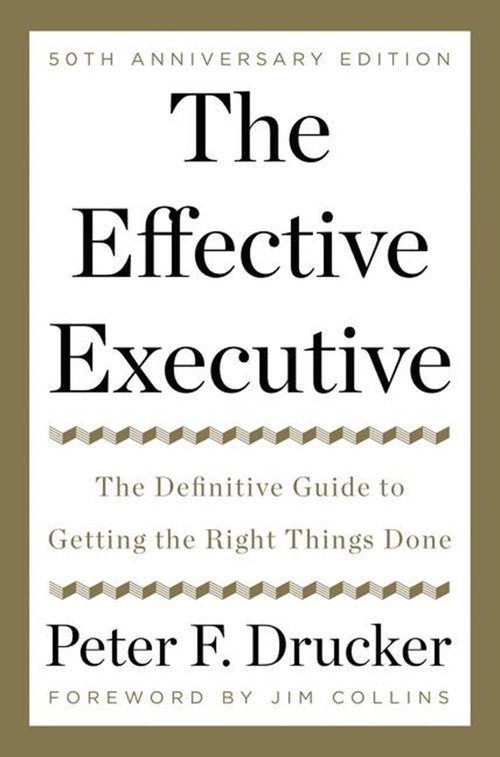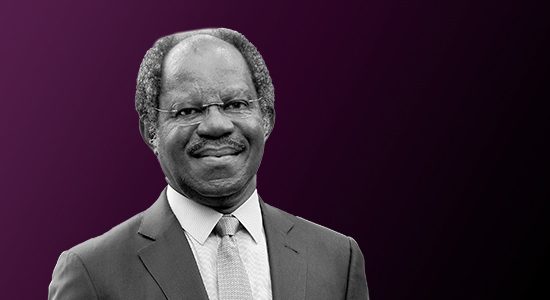The Effective Executive: they concentrate on one task, if at all possible. After picking what needs to be done, set priorities and stick to them.
Print | eBook (Kindle) | Audiobook
In Effective Executive, Peter Drucker shares some very great insight for becoming an effective executive such as organizing and managing your time, choosing your contribution to the organization, amplifying your strengths, setting the right priorities, and making effective decisions.
I highly recommend this Peter Drucker classic as it contains lots of anecdotes, insights, and practical examples on doing the right things effectively and making the right decisions daily.
Here are my favourite takeaways from reading, Effective Executive by Peter Drucker:
Managing Oneself
The core theme of the effective executive book is managing oneself for effectiveness. That one can truly manage other people is by no means adequately proven. But one can always manage oneself. Indeed, executives who do not manage themselves for effectiveness cannot possibly expect to manage their associates and subordinates. Management is largely by example. Executives who do not know how to make themselves effective in their own job and work set the wrong example.
Effectiveness
Effectiveness is what executives are being paid for, whether they work as managers who are responsible for the performance of others as well as their own, or as individual professional contributors responsible for their own performance only. Without effectiveness there is no “performance,” no matter how much intelligence and knowledge goes into the work, no matter how many hours it takes.
Effectiveness is a discipline. And, like every discipline, effectiveness can be learned and must be earned.
Intelligence, imagination, and knowledge are essential resources, but only effectiveness converts them into results. By themselves, they only set limits to what can be attained.
Write an Action Plan
Without an action plan, the executive becomes a prisoner of events. And without check-ins to reexamine the plan as events unfold, the executive has no way of knowing which events really matter and which are only noise. Time is an executive’s scariest and most precious resource.
The action plan is a statement of intentions rather than a commitment.
Effectiveness vs Efficiency
For manual work, we need only efficiency; that is, the ability to do things right rather than the ability to get the right things done. Working on the right things is what makes knowledge work effective. This is not capable of being measured by any of the yardsticks for manual work.
The knowledge worker cannot be supervised closely or in detail. He can only be helped. But he must direct himself, and he must direct himself toward performance and contribution, that is, toward effectiveness.
Efficiency: The ability to do things right
Effectiveness: The ability to get the right things done.
Effectiveness, in other words, is a habit; that is, a complex of practices. And practices can always be learned. Practices are simple, deceptively so; even a seven-year-old has no difficulty in understanding a practice. But practices are always exceedingly hard to do well. They have to be acquired, as we all learn the multiplication table; that is, repeated ad nauseam until “6 x 6 = 36” has become unthinking, conditioned reflex, and firmly ingrained habit. Practices one learns by practicing and practicing and practicing again.
Habits of Effective Executives
- Effective Executives know where their time goes.
- Effective Executives focus on outward contribution
- Effective Executives build strengths
- They concentrate on the few major areas where superior performance will produce outstanding results
- They make executive decisions
They do first things first
They do second things not at all
The Effective Executive on Staffing
The effective executive fills positions and promotes on the basis of what a man can do. He does not make staffing decisions to minimize weaknesses but to maximize strength. Whoever tries to place a man or staff an organization to avoid weakness will end up at best with mediocrity.
Strong people always have strong weaknesses too. Where there are peaks, there are valleys. And no one is strong in many areas.
There is a great story cited in the book about focusing on peoples strength and not their weakness. The Effective Executive asks What does he contribute? not How does he get along with me? He asks what can he do uncommonly well? not what can a man not do?
The story is about General Robert E. Lee, it illustrates the meaning of making strength productive. One of his generals, the story goes, had disregarded orders and had thereby completely upset Lee’s plans—and not for the first time either. Lee, who normally controlled his temper, blew up in a towering rage. When he had simmered down, one of his aides asked respectfully, “Why don’t you relieve him of his command?” Lee, it is said, turned around in complete amazement, looked at the aide, and said, “What an absurd question—he performs.
The Effective Executive knows that the test of an organization is not genius. It is its capacity to make common people achieve uncommon performance.
Priorities and Posteriorities
Setting priorities, everybody can do that setting posteriority deciding what task not to tackle, and sticking to the decision is vital. The reason why so few executives concentrate is the difficulty of setting “posteriorities”—that is, deciding what tasks not to tackle—and of sticking to the decision.
Setting a posteriority is also unpleasant – Every posteriority is somebody else’s top priority.
Concentration—that is, the courage to impose on time and events his own decision as to what really matters and comes first—is the executive’s only hope of becoming the master of time and events instead of their whipping boy.
The effective executive aims beyond himself by focusing on contribution. This requires turning one’s attention away from “one’s own specialty, one’s own narrow skills, one’s own department,” Drucker writes, “and toward the performance of the whole.
Drucker retells a favorite story about three stonecutters who were asked what they were doing:
“The first replied: “I am making a living.” The second kept on hammering while he said: “I am doing the best job of stonecutting in the entire county.” The third one looked up with a visionary gleam in his eyes and said: “I am building a cathedral.”
The Stone cutter story
|
The last person is the one who is ready for effectiveness. He is focused outward, on contribution. It is likely, of course, that along the way he will make a living. He may even become the best stonecutter in the county. But for the effective executive, gain and glory are only ever side effects of doing the right things well.
Focus on Peoples Strength not their Weakness
In every area of effectiveness within an organization, one feeds the opportunities and starves the problems. Nowhere is this more important than in respect to people. The effective executive looks upon people including himself as an opportunity. He knows that only strength produces results. Weakness only produces headaches—and the absence of weakness produces nothing.
He knows, moreover, that the standard of any human group is set by the performance of the leaders. And he, therefore, never allows leadership performance to be based on anything but true strength.
The Roger Bannister Story
In sports we have long learned that the moment a new record is set every athlete all over the world acquires a new dimension of accomplishment. For years no one could run the mile in less than four minutes. Suddenly Roger Bannister broke through the old record. And soon the average sprinters in every athletic club in the world were approaching yesterday’s record, while new leaders began to break through the four-minute barrier.
In human affairs, the distance between the leaders and the average is a constant. If leadership performance is high, the average will go up. The effective executive knows that it is easier to raise the performance of one leader than it is to raise the performance of a whole mass. He therefore makes sure that he puts into the leadership position, into the standard-setting, the performance-making position, the man who has the strength to do the outstanding, the pace-setting job. This always requires focus on the one strength of a man and dismissal of weaknesses as irrelevant unless they hamper the full deployment of the available strength.
The task of an executive is not to change human beings. His task is to multiply performance capacity of the whole by putting to use whatever strength, whatever health, whatever aspiration there is in individuals.
All the best in your quest to get better. Don’t Settle: Live with Passion.



2 Comments
Pingback: The Top 12 Books on Productivity. – Lanre Dahunsi
Pingback: 100 Books Reading Challenge 2020 – Lanre Dahunsi